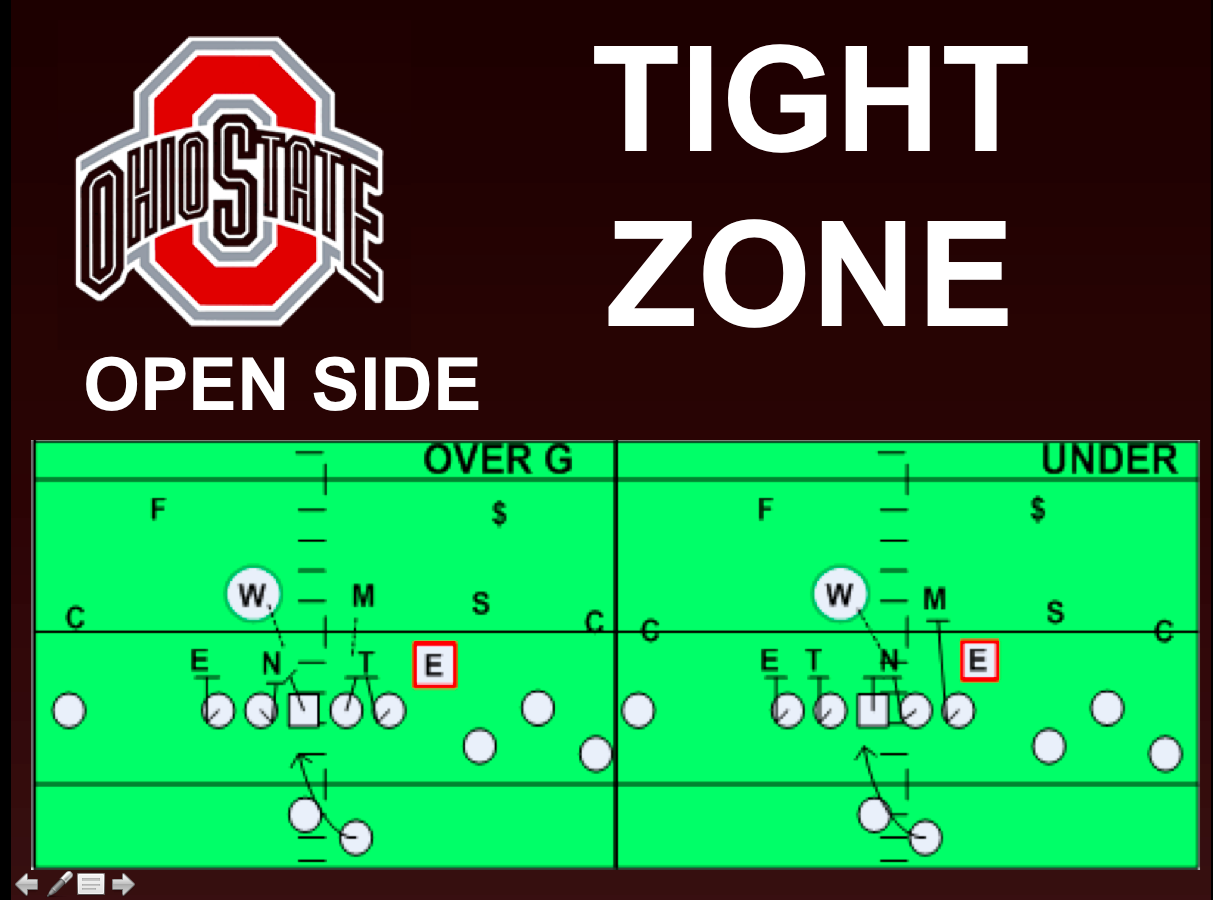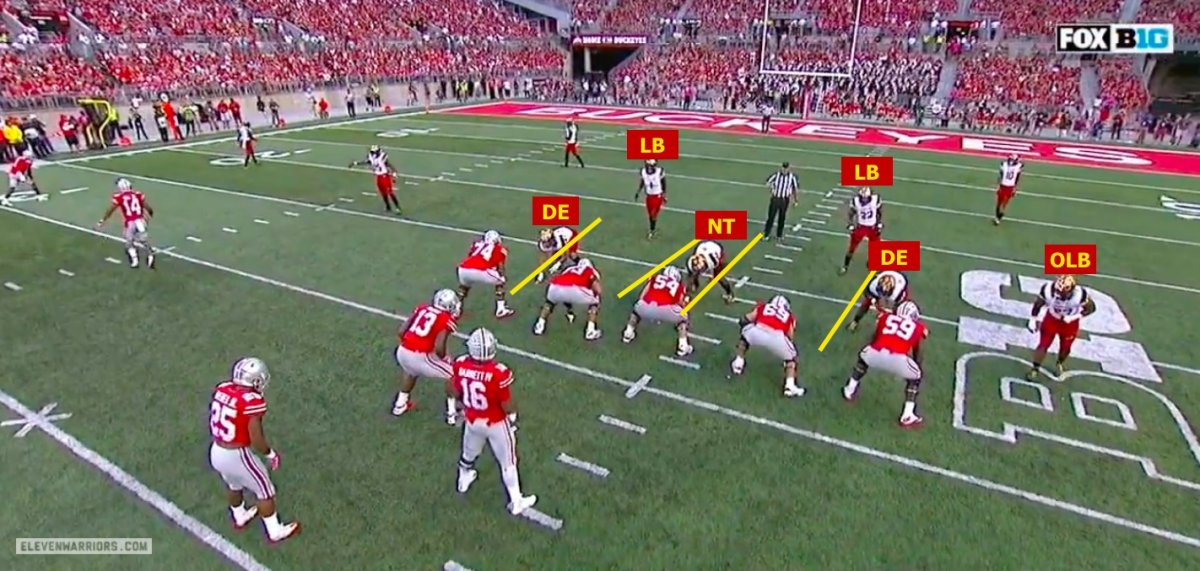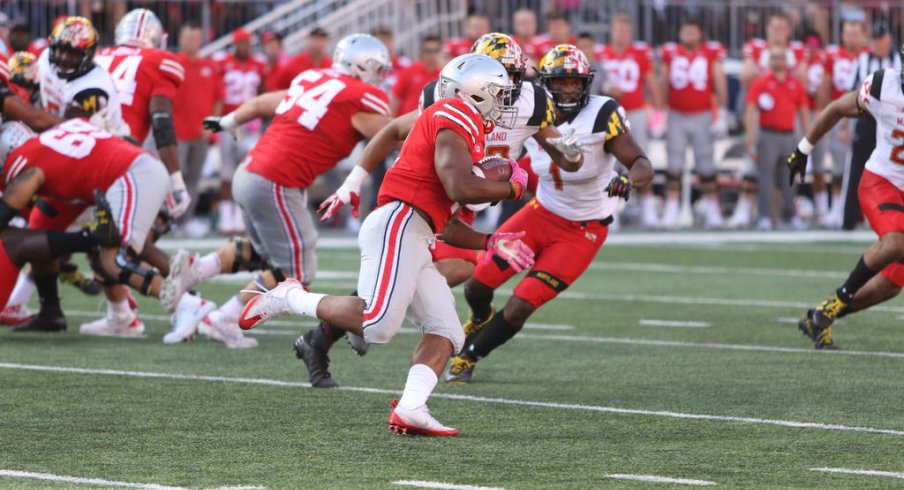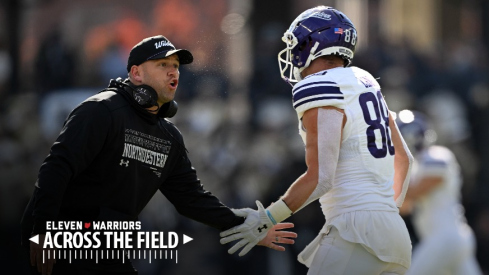Through five games, the Buckeye running game was rolling.
Though the offense as a whole failed to move the ball consistently in their lone loss of the season thus far, it's easy to forget that Ohio State still averaged a solid 4.91 yards-per-attempt against the Sooners.

That should come as no surprise to those watching the Urban Meyer era closely in Columbus, as his teams have always made the inside running game the foundation of their game plans. Typically, that has meant a reliance on the 'tight zone' run meant to hit the 'A' gap opposite the back's alignment, with the runner reading the double-team block(s) in front of him.
Given that Meyer has been leading teams for the better part of two decades, opponents have caught on and tried to find ways to slow down the basis of his offense. One of the most successful ways of doing so has been the use of 'odd' defensive fronts that place a nose tackle directly over the Buckeyes' center.
Typically, defenses like to put their linemen in the gaps between blockers, allowing them to more easily fill any potential running lanes. But against teams like the Buckeyes that rely so heavily on the tight zone, odd alignments render the critical double-team blocks neutral, as blockers are forced to choose between doubling a down lineman or getting upfield to take out a linebacker, often leaving their teammates in a vulnerable position.
The Buckeyes have seen a number of variations on this tactic ever since Virginia Tech caught them off-guard with the 'Bear' front four seasons ago. But Maryland typically runs a three-man front, allowing them to easily slide last Saturday into an alignment their opponents typically find so uncomfortable.
Unlike the Bear, which places both defensive ends over the offensive guards, the Terrapin ends lined up just on the inside shoulders of Ohio State's tackles in a 4i look.

For anyone looking for evidence the Buckeye offense has improved under the leadership of Kevin Wilson and Ryan Day, last weekend's systematic demolishing of this odd front (against an in-conference opponent, no less), should offer plenty.
Ohio State had struggled in recent years to find any offensive rhythm against such looks, even when facing far lesser opponents than Maryland. But the Terps proved to be no match this year, as even though much of the focus was (justifiably) on the Buckeyes' 303 passing yards that afternoon, they also racked up 281 yards on the ground at an efficient clip of 5.6 ypc.
With so much focus on the Buckeye passing game, it's been easy to overlook how relatively vanilla their run game had been so far this year, relying almost exclusively on tight zone and showing few of the other wrinkles we've become used to in Meyer's offense (such as Counter-trey, Buck Sweep, and the Jet Sweep). This has been partly due to their opponents' reliance on four-man fronts that leave the natural A-gap 'bubble' for the tight zone to hit.
But this week the game plan for running the football offered a buffet of options to attack the edges of the Maryland defense, as the 4i look of both defensive ends created natural running lanes of their own. The most common way the Buckeyes attacked them was with 'Bash,' the concept that flips the typical tight zone on its head by swapping the roles of the running back and quarterback. With the end aligned inside, the tackle can easily leave him unblocked to be read and get upfield to set the crucial block on a linebacker at the second level.
While the Buckeyes ran it from a number of alignments, the 2x2 set with four split receivers seemed to be the most effective, as J.T. Barrett would easily flip the play based on the defense's positioning before the snap. However, the backfield action was enough to sway the Terps to overplay the speed sweep to either J.K. Dobbins or Mike Weber, leading to one of the Buckeyes' biggest plays of the day: a reverse to H-receiver Parris Campbell.
'Bash' has been in the Buckeye playbook for years, but it's hard to recall a contest in which it was called as early and often (and with additional wrinkles) as the one we watched last weekend.
But the game plan for attacking the edges didn't stop there. After Day drew attention for incorporating the passing schemes of his former boss, Chip Kelly, Wilson was apparently not to be outdone and pulled out a few tricks of his own.
At Indiana, Wilson's teams regularly pulled the tight end into the backfield to act as a lead blocker for the tailback, allowing the Hoosiers to still use traditional 2-back concepts from the shotgun. For the first time, we saw such a look from the Buckeyes, with tight ends Marcus Baugh and Rashod Berry lined up almost right next to Barrett in the backfield with the tailback slightly behind.
This look is slightly different from the 'Pistol' formation, as although it allows the offense to run many of the same plays found in 'Pistol' offenses, Barrett still remained at the same, five-yard depth behind the center as always. By putting the tight end this deep in the backfield, the Buckeyes were combining the best of two worlds - the I-formation and spread-option football.
Wilson introduced Buckeye fans to a new variation of the zone running game, as the tight end leads the runner through the B-gap between the guard and tackle and takes on the linebacker that often goes unblocked against odd fronts. But unlike I-formation zone runs (in which the QB simply turns around to handoff and is out of the play), Barrett is still a threat, as he reads an unblocked defender and can either run or throw a bubble screen to the opposite side of the run.
While none of the three elements introduced in this concept are new at all (a lead-zone run, a zone-read decision from the QB, and the option to throw the bubble screen), their combination puts a great deal of horizontal stress on the defense. Stopping any running game is about ensuring that every potential gap is filled, and the Buckeyes not only added an additional inside gap by bringing the tight end in the backfield, they forced the secondary to stay home with the other elements.
But as mentioned earlier, the OSU offense was almost perfectly balanced in the 62-14 demolishing of the Terrapins, and that wasn't just by coincidence. The Buckeyes have worked to build a rollout passing game all season, looking to get Barrett outside the pocket and give him simple reads through the air in short-yardage and red zone situations.
Against the Terps' alignment, though, the Buckeyes were naturally set up to attack. Not only could the inside alignment of the ends allow the tackle and guard to seal the edge, the running back could easily identify his blocking assignment and give Barrett a clear throwing lane - one he'd beautifully take advantage of with a textbook touchdown throw.
Perhaps more than any game plan in recent memory, the Buckeyes seemed ready for the challenge that awaited that last Saturday and didn't hesitate to call on new concepts to attack the Terrapin defense. While their performance wasn't perfect, especially after Matthew Burrell replaced the injured Brandon Bowen at right guard, the first-team offense was only forced to punt once all afternoon.
Though some of this success is simply the byproduct of two months of practice, the Buckeye offense is being put into the position to succeed by their coaches. While many will quickly dismiss any performance before the season-defining matchup with Penn State on October 28th, it's clear which way the unit is trending, and not just because of the talent on the field.



